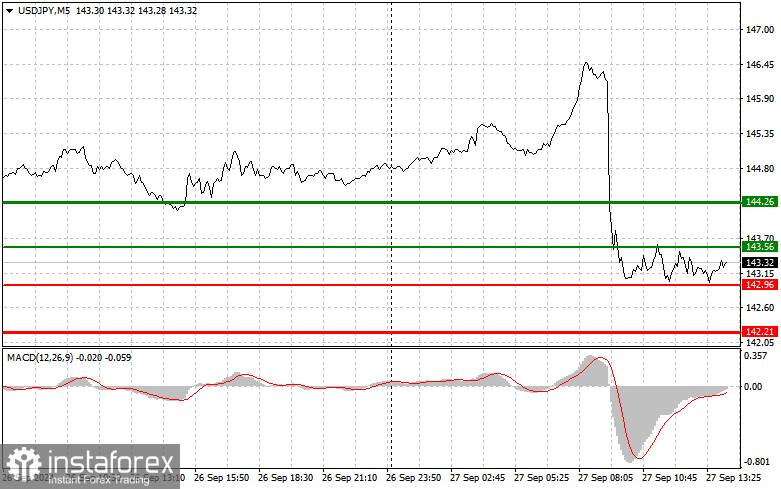Analysis of Trades and Trading Tips for the Japanese Yen
The test of the 143.09 price level occurred when the MACD indicator moved significantly below the zero mark, limiting the pair's downward potential. For this reason, I didn't sell the dollar. The second test of 143.09 shortly afterward happened when the MACD was already recovering from the oversold area, offering a chance for a correction in the pair, which I took advantage of. As a result, the pair rose by about 40 points before the dollar encountered renewed selling pressure. The sharp sell-off of the dollar and the strengthening of the yen were directly related to a recent political development in Japan, which I discussed in detail in my morning forecast.
In the second half of the day, we have several reports ahead. These include the core Personal Consumption Expenditures (PCE) index, changes in household spending and income, the U.S. trade balance of goods, and the University of Michigan Consumer Sentiment Index. If the indices and income levels of Americans rise, the dollar will likely recoup some of its losses, and the yen will weaken. However, if the data falls short of economists' forecasts, the USD/JPY pair will likely continue to decline. For my intraday strategy, I plan to act based on Scenario #1 and Scenario #2.

Buy Signal
Scenario #1: Today, I plan to buy USD/JPY at the entry point around 143.56 (green line on the chart) with a target of rising to 144.26 (thicker green line on the chart). At 144.26, I will exit my purchases and open short positions in the opposite direction, expecting a retracement of 30-35 points. You can expect the pair's rise today only if there is strong U.S. data. It is important that before buying, you ensure the MACD indicator is above the zero mark and just starting to rise.
Scenario #2: I also plan to buy USD/JPY today in the case of two consecutive tests of the 142.96 price level when the MACD indicator is in the oversold area. This will limit the pair's downward potential and trigger an upward market reversal. Expect a rise towards the levels of 143.56 and 144.26.
Sell Signal
Scenario #1: Today, I plan to sell USD/JPY after it reaches the 142.96 level (red line on the chart), which will likely lead to a quick decline in the pair. The key target for sellers will be the 142.21 level, where I will exit my sales and immediately open long positions in the opposite direction, expecting a retracement of 20-25 points. Pressure on the pair will return if U.S. statistics are weak. It is important that before selling, you ensure the MACD indicator is below the zero mark and just starting to decline.
Scenario #2: I also plan to sell USD/JPY today in the case of two consecutive tests of the 143.56 price level when the MACD indicator is in the overbought area. This will limit the pair's upward potential and lead to a market reversal downward. You can expect a decline to the levels of 142.96 and 142.21.

What's on the Chart:
- Thin green line – the entry price at which you can buy the trading instrument.
- Thick green line – the anticipated price where you can set Take Profit or manually secure profits, as further growth above this level is unlikely.
- Thin red line – the entry price at which you can sell the trading instrument.
- Thick red line – the anticipated price where you can set Take Profit or manually secure profits, as further decline below this level is unlikely.
- MACD Indicator: When entering the market, it's important to consider overbought and oversold zones.
Important: Beginner forex traders should be very cautious when making market entry decisions. Before the release of major fundamental reports, it's best to stay out of the market to avoid sharp price fluctuations. If you decide to trade during news releases, always set stop-loss orders to minimize losses. Without stop-loss orders, you can quickly lose your entire deposit, especially if you don't use money management and trade large volumes.
It is essential to remember that for successful trading, having a clear trading plan, such as the one presented above, is crucial. Making spontaneous trading decisions based on the current market situation is inherently a losing strategy for an intraday trader.
 English
English 
 Русский
Русский Bahasa Indonesia
Bahasa Indonesia Bahasa Malay
Bahasa Malay ไทย
ไทย Español
Español Deutsch
Deutsch Български
Български Français
Français Tiếng Việt
Tiếng Việt 中文
中文 বাংলা
বাংলা हिन्दी
हिन्दी Čeština
Čeština Українська
Українська Română
Română

